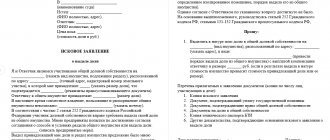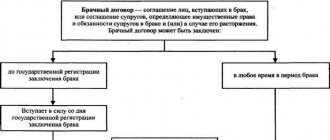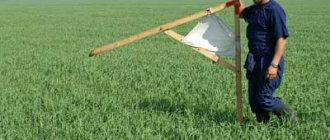An agreement on the division of a land plot can be concluded only between co-owners who wish to transform the common ownership of the land plot into shared ownership, with the allocation to each of the corresponding ideal or natural shares. Files in .DOC: Form of agreement on the division of a land plotSample agreement on the division of a land plot
Types of shares
There are two types of shares - ideal and real.
Ideal shares are property, the boundaries of which are not defined in nature. To put it simply, the ideal share is the number of tenths or hundredths of the value of a land plot that its owner can claim. For example, the owner of ¼ of the property, if the entire plot is sold for 100,000 rubles, can claim 25,000 rubles.
As a rule, owners of shares in a common property become the result of inheritance or in the case of acquiring a share as a result of a purchase and sale agreement.
Real shares in common property are, in fact, a plot that has its own location, boundaries and, possibly, fenced and has a separate cadastral number.
Of course, by general agreement between the co-owners, some semblance of boundaries for each share on the site can be provided, but this will not be a full allocation of the share.
If there are buildings on the site
If there are buildings on the territory of the land plot, the issue of dividing the buildings themselves is decided.
Buildings can be divided if:
- each half of the building has a separate exit to the street;
- both parts of the building have an electrical panel and a functioning heating and power supply system;
- the building has several windows suitable for illuminating the rooms;
- the building and all its parts comply with established sanitary standards.
If it is impossible to divide the house in kind, the owners again draw up a voluntary agreement, as a result of which one becomes the owner of the building, while the other receives compensation in money.
No plot can be divided without technical expertise. When dividing land with a building, the building is first divided, and then a certain part is allocated to each owner.
How to divide a plot
Let us repeat that division of a land plot through an agreement is possible only between co-owners. If the land plot has a single owner, then he can “divide” it in the following ways:
- by donating part of the land plot;
- by alienating part of the land plot;
- as a result of a court decision, for example, during the division of joint property of spouses, if it is proven that the plot was received during the marriage. In this case, the common property of the spouses will turn into shared property.
As for the co-owners, they can turn their ideal share into a real one:
- by concluding an agreement among themselves;
- by going to court with a claim for division of a land plot.
Regardless of the method, the result will be the same - the co-owners will turn into owners and in the future will be able to fully manage their part of the land plot.
Dividing the land: when you can and when you can’t
In accordance with current legislation, the division of a land plot is a procedure in which several new plots are formed, and the original one ceases to exist. But not all landholdings are divisible.
The division of land is permitted subject to the following conditions:
- the original intended purpose of the land should not change (the dacha plot does not have the right to turn into agricultural land);
- the area of the resulting plot should not be less than the minimum norm established by law (you cannot divide 6 acres into 100 plots of 6 meters each);
- each formed territory has an entrance or passage;
- There is no legal prohibition on manipulation of land or encumbrance (seizure) on it.
There is a requirement to comply with the minimum size of a land plot during division, but this size differs from region to region, since it is set by regional authorities
By the way : How to find out who owns a plot of land?
Agreement between spouses
If you do not want to go through the judicial procedure of dividing property, you can try to divide it yourself.
The land plot (provided that it was acquired during the marriage) does not have to be divided equally between the spouses. The law provides for a derogation from equality of shares in favor of one or the other spouse.
For example, the court, when considering cases of division of property, deviates from equality in favor of the spouse who is raising children. In addition, the contribution of each spouse to the acquired property or the spouse's need for this property may be taken into account. So, if a plot is a source of income for a husband or wife, then he will be able to claim a larger ideal share of the plot. Precisely ideal, since a completely different procedure is provided for selecting a site in nature.
Whatever the agreement of the parties, and no matter how they divide the land, the agreement must be in writing.
Let's sum it up
Dividing land ownership into two or more parts is usually quite feasible. Just remember that the minimum area of land during division must comply with the standards established in the region. Thus, for growing a vegetable garden, the size of the plot is usually set at least 4 acres, and for country house or housing construction - at least 5 acres. Please check with your local administration for the specific minimum permissible landholding size.
About the author of the article
Elena Turkina Practicing trial lawyer. Lives and works in St. Petersburg.
Divisible and indivisible plots
It will not be possible to drive in the pegs yourself, since ownership of land plots is subject to state registration.
In general, the procedure for dividing and allocating land plots is regulated by the Land Code of the Russian Federation, namely Articles 11.4 and 11.5, as well as the Civil Code of the Russian Federation and the Law “On Land Turnover”. Article 11.4 concerns the issue of dividing a plot into shares with common ownership, and Art. 11.5 concerns allocation, that is, the transformation of an ideal share into a real one.
Thus, the Civil Code of the Russian Federation (Article 133) divides all land plots into divisible and indivisible. Therefore, the first thing co-owners should do is find out which category their plot belongs to. If it is indivisible, then the question of division will disappear forever.
The indivisibility of a plot is established based on:
- characteristics of the land (landscape, location, soil, etc.);
- the possibility of division without violating the regime of use of the land plot. For example, if there is a house in common ownership on a plot, then it will be possible to divide this plot only with the simultaneous division of the house.
The land under an apartment building is not subject to division in real shares, and can only be divided into ideal shares between apartment owners.
The possibility of partitioning is also limited by:
- easements registered on the site;
- long-term lease agreements;
- mortgage and other encumbrances.
A complete list of restrictions is given in Article 11.9 of the RF Land Code.
So, before you start drawing up an agreement, you should find out the status of the land. Determining this issue is a lengthy process as it involves several procedures, including assessing the size limits of the site. Thus, the plots obtained as a result of division should not be below the norm of permitted use. This means that to determine the possibility of a partition, a parameter such as VRI (type of permitted use) is also used.
If according to all parameters the division of the site is acceptable, then based on the results of the drawn up agreement it will be necessary to determine the boundaries of the site on the ground, that is, to carry out land surveying.
Can any piece of land be divided?
A land plot can be in personal, shared or joint ownership. If only one person has ownership of land, then he can divide the property independently without taking into account the opinions of other persons.
It is a completely different matter when the land is in shared or joint ownership. This means that the object has multiple owners. Division is possible with the consent of each of them. If at least one of the owners refuses to divide, then carrying out the procedure will be extremely difficult, and in many cases even impossible.
In addition, land plots can be divided into:
- divisible - the plot can be divided while maintaining its characteristics;
- indivisible - the plot cannot be divided, since the new plots will not fit into the declared standards.
Restrictions on division may affect the form of ownership and intended purpose. It is impossible to divide the land if after the procedure the plot changes its intended purpose. For example, if you plan to divide a plot of land intended for individual housing construction (individual housing construction), then the new plots must have exactly the same purpose.
The division of land is not allowed if after this the area of the newly formed plots becomes less than the permissible minimum size. The standard varies depending on the purpose and status of the land plot.
Even in cases where the allotment complies with the standards and is divisible, division will not work if one of the owners is against it. This also applies to situations where the plot is shared by a husband and wife. Everything will depend on who owns the disputed land.
If it is in joint ownership, division can take place if both spouses do not object. However, an object is not divided if it belongs to only one of the spouses as personal property. This is possible when the object was privatized, received as a gift, inherited, or purchased with personal funds.
In this case, the situation can be changed if the land was improved, landscaped and ennobled at the expense of both the husband and wife. When these actions have led to an increase in the price of the plot, the plot can be divided.
The division of land in respect of which an encumbrance has been imposed (seizure, pledge, etc.) is not allowed. In addition, if it is obvious that after division access to one of the newly created plots will be blocked, its registration is also impossible.
When division is not possible, owners can do one of the following:
- renounce their shares in the right of common property in favor of one person, who, in turn, will pay monetary compensation to the rest;
- sell the plot and divide the proceeds equally;
- draw up an agreement on the procedure for using the allotment.
If nothing prevents the division, then it is necessary to conclude an appropriate agreement.
Where to contact
First of all, the plot that the co-owners wish to divide must:
- be registered in the cadastral register;
- have established boundaries on the cadastral plan;
- to be divisible;
- be unencumbered by obligations (for example, an easement).
If the plot meets all these conditions, then to divide it, the co-owners must take the following actions:
- draw up an agreement for the division or allotment of shares;
- on the basis of an agreement, enter into an agreement with a company that has a license to carry out land surveying work;
- contact the cadastral authority to assign postal addresses to the allocated areas;
- put new plots on cadastral registration;
- register the agreement with Rosreestr and obtain ownership rights.
The division of a land plot is understood as a set of measures as a result of which two or more land plots are formed from one land plot. A land plot can be divided on the basis of an agreement on the division of a land plot with the consent of all its owners or by a court decision.
The newly formed plots must meet the requirements established by the legislation of the Russian Federation, in particular the requirement on the maximum size of the land plot.
The maximum (maximum and minimum) sizes of land plots are determined by town planning regulations or land legislation (in relation to plots to which town planning regulations do not apply).
To divide a land plot, we recommend following the following algorithm.
1. Carry out cadastral work to survey the land plot
Conclude a contract for cadastral work with a cadastral engineer (IP) who is a member of a self-regulatory organization of cadastral engineers, or with an organization that has a cadastral engineer on staff.
The boundaries of a land plot are established in the presence, in particular, of the owners, possessors or users of the demarcated and adjacent land plots. Instead, their representatives may be present during the land survey by proxy.
The cadastral engineer will establish the boundaries of the resulting land plots and draw up a boundary plan.
The boundary plan may be placed for temporary storage in an electronic storage facility maintained by the rights registration authority.
2. Draw up an agreement on the division of the plot or obtain a court decision on the division of the plot
The agreement is drawn up in simple written form and signed by all owners of the divided land plot. At your request, the agreement can be certified by a notary.
The agreement provides the address and cadastral number of the divided land plot, information about its owners. It is indicated that the owners of the plot have decided to divide it, and it is described exactly how the division is made (for example, in proportion to the shares in the common property right).
If one or more owners of a land plot do not agree to enter into an agreement on its division, it will be necessary to apply to the magistrate or district court at the location of the plot with a claim for its division.
The jurisdiction of a case on the division of a land plot depends on its value: a claim on the division of a land plot worth 50,000 rubles. and less should be presented to the magistrate, in other cases - to the district court.
3. Assign addresses to newly created land plots
Apply for the assignment of separate addresses to newly formed land plots to the authorized local government body or government body of the constituent entities of the Russian Federation - cities of federal significance.
The application can be submitted in person or through a representative, sent by mail, transmitted through the MFC or sent in the form of an electronic document, including through the Unified portal of state and municipal services (functions), the regional portal of state and municipal services (functions) or the portal of the federal information address system through the Internet.
The decision to assign an address, as well as the decision to refuse such assignment, is made within no more than 18 working days from the date of receipt of the application.
4. Contact Rosreestr for cadastral registration and registration of ownership of the resulting plots
When dividing a land plot, state cadastral registration and state registration of rights to the formed land plots, as well as deregistration and termination of ownership of the original land plot are carried out simultaneously.
To register the right to the state cadastral register and state registration of the right, the following documents must be submitted:
1) identity document;
2) an application for state cadastral registration and state registration of rights to land plots;
3) decision on assignment of addresses;
4) an agreement of owners or a court decision on the division of a land plot;
5) a document confirming authority, if the application is submitted by a representative.
6) Land survey plan in electronic form. If the boundary plan is placed in electronic storage, its identifying number can be indicated in the application. In this case, the provision of a boundary plan will not be required.
A state fee must be paid for registering ownership of land plots. It is not necessary to submit proof of payment along with the application. The applicant has the right to do this on his own initiative. However, if there is no information about the payment of the state duty in the State Information System on state and municipal payments, after five days from the date of filing the application, Rosreestr will return the application and the documents attached to it without consideration.
The amount of state duty when registering ownership of a land plot depends on the category of land and the type of permitted use of the plot:
— 350 rub. - in relation to a plot intended for personal subsidiary farming, dacha farming, vegetable gardening, horticulture, individual garage or housing construction, as well as a plot with an equivalent type of permitted use or a plot from the category of agricultural land of other types of permitted use;
— 2,000 rub. - in other cases.
If it is possible to submit an application and pay the state fee through government services portals and other portals integrated with the Unified Automated Identification of Information System (USIA), the state fee is calculated with a coefficient of 0.7.
The application and necessary documents can be submitted to Rosreestr in one of the following ways:
- directly to the Rosreestr branch or through the MFC (regardless of the location of the property according to the list of divisions that carry out reception on an extraterritorial basis posted on the Rosreestr website) or to an authorized person of Rosreestr during on-site reception;
- by postal item with a declared value when forwarding it, a description of the contents and a notification of delivery (in this case, the authenticity of the signature on the application must be notarized, the agreement and power of attorney of the representative must be notarized, and copies of identification documents must be attached);
- in the form of electronic documents via the Internet, for example through the official website of Rosreestr.
If at the time of submission of the application the state duty has not been paid, the applicant is issued or sent information containing a unique payment identifier (unique accrual identifier) necessary to confirm the fact of payment for a specific service for payment of the state duty, indicating the date by which it must be paid.
You can pay the state fee for state registration, including through the MFC.
5. Receive documents after cadastral registration and state registration
Cadastral registration and state registration of land plots are carried out within 10 working days from the date Rosreestr receives the application and documents. If the application was submitted through the MFC, the processing time for the application will be 12 working days. This period begins on the next working day after the date of receipt of documents.
State registration and cadastral registration are certified by an extract from the Unified State Register of Real Estate, which can be sent to the applicant in electronic form.
Contents and form of the agreement
The consent of the co-owners to the division of the land plot is formalized in writing. The law does not require mandatory notarization for this category of transactions, but it is still better not to skimp and visit a notary.
The fact is that share legal relations are complex even for lawyers, especially when the number of shares is large. People who are not versed in jurisprudence can easily get confused in their definition. The notary, in addition to checking the correctness of the shares, will also check the accuracy of the contents of the agreement.
To draw it up yourself, we recommend taking as a basis the standard template of agreements of the type in question available on the website.
The text of the agreement must be complete and unambiguous. This will be easy to achieve if you follow the example list of information that the agreement should contain. Thus, the text of the agreement should include:
- the date the agreement was drawn up and the locality in which it was drawn up;
- listing of all co-owners of the site, indicating their passport details and addresses;
- name of the document on the right of common or shared ownership;
- registration number in the Unified State Register;
- method of dividing the site;
- the size of the shares of each co-owner;
- the procedure for paying the costs of land surveying, registration of land surveying and registration of shares allocated to co-owners;
- condition for the termination of common ownership. This refers to the obligation of each party to the agreement to register ownership of their share;
- address and cadastral number of the divided plot;
- expression of consent to division from each of the co-owners;
- signatures of all parties to the agreement.
Sample agreement on determining shares in a land plot
The document does not have a set form. However, in practice, the document should contain the following information:
- name of the agreement;
- city of registration;
- date of conclusion;
- data of the parties;
- information about the site (address, area);
- cadastral number of the plot;
- notes on the voluntary execution of the document;
- information about the sanity of the parties;
- procedure for dividing expenses;
- signatures.
Sample agreement on determining shares in a land plot
Land surveying works
Land surveying is necessary to determine the boundaries of the plots allocated to each of the co-owners. Only organizations that have received a state license for this type of activity have the right to carry out land surveying work. This means that this organization has a cadastral engineer on staff.
To conclude an agreement with such an organization, the co-owners must provide it with a copy of the agreement and enter into a contract agreement with it for the implementation of land surveying work.
In the process of executing a contract, the land management organization performs the following actions:
- receives an extract from the cadastral book;
- requests a land plot plan from the State Cadastre;
- studies documentation;
- evaluates the location of the site and adjacent lands to establish a reference point;
- resolves the issue of the need to conduct a geodetic examination;
- establishes the boundaries and areas of allocated land plots in proportion to the shares of co-owners;
- draws up a boundary plan;
- enters a boundary plan into the real estate cadastre.
If all co-owners agree with the prepared land survey plan, the cadastral engineer draws up an agreement, in which all co-owners will have to put their signatures. If there are disagreements between co-owners, the cadastral engineer will draw up a new plan. If it is impossible to achieve agreement, the cadastral engineer will stop work and invite the co-owners to go to court.
Section options
There are several legal ways to distribute responsibility among new owners.
Into equal parts
The total area of land is divided according to the number of expected owners, after which the position of the boundaries is determined. If the new plots meet the requirements, the transaction can be registered with Rosreestr.
Into unequal parts
It is possible to define new areas with different areas:
- if the original allotment was inherited and the successors had different shares in the total inheritance;
- if the owners agree to an unequal division, indicate this in the agreement and confirm it with signatures.
With compensation
Monetary compensation can replace ownership of the plot:
- if one of the share owners does not want to participate in the division, the rest pay him compensation in the amount of the cost of his part. This responsibility is divided equally or as a percentage among the remaining owners;
- if there are three or more owners, and one refuses his part in favor of another, he is obliged to pay compensation individually;
- if the plot is recognized as indivisible for any reason, it can be left with one owner, who will compensate the rest for their parts.
Judicially
You will have to go to court if one of the share owners does not agree with the division or does not communicate. The court will make one of the following decisions:
- about the division;
- about the procedure for use;
- about the sale.
Obtaining a mailing address
After receiving the boundary plan, co-owners will have to contact the department of architecture and urban planning at the local executive authority to obtain a separate postal address for each plot.
In addition to the application, they will have to provide:
- a survey document drawn up by a cadastral engineer;
- certificates of each co-owner of ownership of his share;
- cadastral passport of the land plot;
- a copy of the agreement of co-owners or a court decision.
Based on the documents provided, the land plots will be provided with a postal address.
Final stage
After registering a land survey and receiving a postal address, co-owners can apply to Rosreestr to register a separate plot of land for each of them. In addition to the application, you should attach:
- copies of passports;
- decision on assigning a postal address;
- boundary plan;
- a copy of the agreement.
From the moment of registration of the right of each co-owner to the allocated land plot, the common right of ownership will be terminated and each of the co-owners will receive an extract from the Unified State Register of Real Estate on the registration of his right to the land plot.











